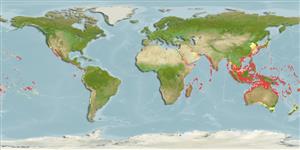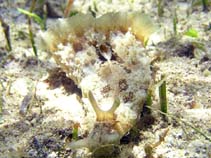Dolabella auricularia (Lightfoot, 1786)
Shoulderblade sea cat| Native range | All suitable habitat | Point map | Year 2050 |

|
| This map was computer-generated and has not yet been reviewed. |
| Dolabella auricularia AquaMaps Data sources: GBIF OBIS |
Classification / Names Common names | Synonyms | CoL | ITIS | WoRMS
Gastropoda | Aplysiida | Aplysiidae
Environment: milieu / climate zone / depth range / distribution range Ecology
Benthic; depth range 2 - 71 m (Ref. 101222). Tropical
Distribution Countries | FAO areas | Ecosystems | Occurrences | Introductions
Indo-Pacific.
Length at first maturity / Size / Weight / Age
Maturity: Lm ? range ? - ? cm Max length : 50.0 cm TL male/unsexed; (Ref. 822); common length : 12.0 cm BASL male/unsexed; (Ref. 349); max. published weight: 500.00 g (Ref. 2594)
Common among seaweeds and grass flats in shallow water environments, especially in sheltered bays and lagoons (Ref. 349). Found during the day under rocks and at night crawling around reef flats and seagrass beds (Ref. 844). Inhabits eel grass beds, reef flats, or tidal swimming pools (Ref. 866). Nocturnal (Ref. 822).
Life cycle and mating behavior Maturity | Reproduction | Spawning | Eggs | Fecundity | Larvae
Members of the order Anaspidea are mostly simultaneous hermaphrodites.
Main reference
References | Coordinator | Collaborators
Poutiers, J.M. 1998. (Ref. 349)
IUCN Red List Status (Ref. 130435)
CITES status (Ref. 108899)
Not Evaluated
CMS (Ref. 116361)
Not Evaluated
Threat to humans
Harmless
Human uses
| FishSource |
Tools
More information
Internet sources
BHL | BOLD Systems | CISTI | DiscoverLife | FAO(Publication : search) | Fishipedia | GenBank (genome, nucleotide) | GloBI | Gomexsi | Google Books | Google Scholar | Google | PubMed | Tree of Life | Wikipedia (Go, Search) | Zoological Record
Estimates based on models
Preferred temperature
(Ref. 115969): 22.6 - 29.1, mean 28 (based on 1616 cells).
Resilience
(Ref. 69278):
High, minimum population doubling time less than 15 months (K=0.8-1).
Price category
(Ref. 80766):
Unknown.



